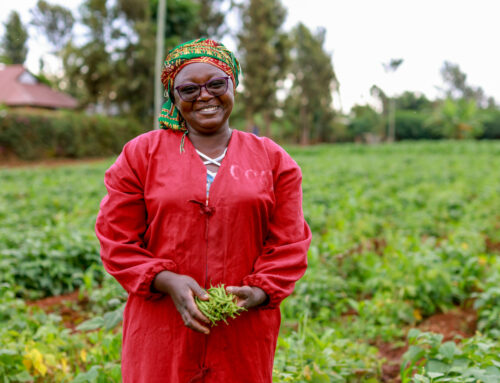Investment of cold chain increases export volume for Ausmoz Farm holdings, Mozambique
Mozambique has had a small export horticultural industry compared to other African countries and has traditionally depended on South African imports. The horticulture farming sector is dominated by small-scale farmers producing 82.9% of the total area under horticulture crops, followed by large-scale commercial farmers with 13.95% according to a report conducted by the Ministry of Foreign Affairs. (Ministry of Economic Affairs, 2021)
According to FAO, the climate in the country supports top quality bananas, citrus, avocados, mangoes, litchis, pineapples, papaya, passion fruit, strawberry and guava and export opportunities also exist for a host of vegetables such as baby corn, bell peppers and paprika. (Food and Agriculture Organization, 2021)
The market opportunities for locally grown vegetables and fruits have been seen to increase through the emergence of opportunities such as import substitution for local consumption, the entrance of supermarkets and the increasing European demand for subtropical fruit and nut basket which is headed-up by macadamias, litchis and avocado.
Reports also show that, the imports of fruit and vegetables from Mozambique have increased considerably with a total growth of 359%, going from 23,334 in 2009 to 83,866 in 2019 as seen below.

The imports of fruit and vegetables from Mozambique 2008-2019 (knoema, 2021)
Mozambique has important competitive advantages over other Southern African countries like Zambia, Zimbabwe and South Africa, such as has excellent comparative advantages climate, seasonality crop choices and good communication links with South Africa. Most of Southern Africa cannot produce frost- sensitive crops like avocado, berries, baby-corn, beans, and chilies during winter months, but a great part of Mozambique territory offers the perfect conditions for producing them, which is becoming an attractive opportunity for entering the export business.
A perfect example of this market opportunity is Ausmoz Farm holdings, a large commercial farm located in Manica Province of Mozambique, about 40 km from the Zimbabwean border. Its main products are litchis and avocados for export.
Ausmoz harvested volumes of litchis are increasing rapidly during the last years. About 90 tonnes was exported as fresh product in 2020, an increase from about 20 tonnes in 2017. They are expecting exponential growth in their litchi and avocado harvests in the next few years. Ausmoz is also planning on investing in canning facilities for litchis to make use of fruit not suited for fresh export markets.
Ausmoz initially used refrigerated containers to establish the cold chain prior to export. This worked well when volumes were initially low, with about 20 tonnes over a 20-day period of harvest and shipment. However, when volumes increased, from the 2018 harvest, these facilities were proven not to be adequate. In consequence, the fruit was not effectively cooled prior to shipment, and much of it developed mould or other features making it un-marketable resulting in very substantial losses.
The main issue was the lack of proper pre-cooling immediately after harvest. The lack of proximate cooling resulted in having the fruit being left for 12 hours at least under environment temperate and not entering the cold chain soon enough, that resulted in important post-harvest losses.
The cold chain had to be established at the farm prior to shipment, then maintained through a process of initial truck shipment to Harare airport, airfreight to UK and Europe, then receival and distribution.
To curb this, Ausmoz invested in an InspiraFarms modular and pre-fabricated cold room of 60 square meters, with pre-cooling capabilities through air-forced cooling and a humidifier, including IoT and data systems. The cold room has a capacity of storing up to 32 pallets or about 20 tons of produce and bringing the temperature down from of 32°C to 8°C or less.

Their process of managing and operating the cold room starts once the fruit is picked from the farm and immediately placed in the pre-cooler cold room. The fruits are then left there for at least 12 hours as the temperature of the fruit is closely monitored until it gets to the right temperature.
The forced air from the InspiraFarms pre-cooling technology rapidly dropped the pulp temperature of the fruit and ensured optimal quality. The pre-cooler also allowed drop of temperature for the fruits to 1-2 degrees Celsius, allowing them to load reefers directly from the farm, which were then trucked to the port for export.

“Since we installed the cold room, we have had no losses. Both air-freight and sea-freight shipments have arrived with the cold chain properly maintained. We use air-freight early in the season when prices for fruit are higher, but after that we use sea-freight due to lower cost. Pre- Cooling the fruit quickly and to the right temperature allowed us to maintain optimal quality and significantly reduced losses resulting to high praise for the quality of our produce,” says Andrew Macpherson, Managing Director of Ausmoz Farm holdings.
Ausmoz Farm holdings current markets are in the UK and Europe and are seeking investment to expand. They need to treble their cooling capacity in the next two years to cater for increased volumes as their orchards mature.
“We are also planning to invest in canning facilities for litchis to make use of fruit not suited for fresh export markets. This means that they will have to include a sizeable cold storage to enable a stock of fruit for ongoing canning,” he added.
For all of this, Ausmoz needs reliable electricity, and plans to invest in solar energy generation and power storage. Their advice to agribusinesses aiming to follow in the same path, is that they should make sure that their fruit cooling facilities are adequate for their harvested and exportable volumes before finding out too late and incurring losses.
Sources:
Agriprofocus.com. 2021. Horticulture and Potato Market Study in Mozambique. [online] Available at: <https://agriprofocus.com/upload/HorticultureandPotatoMarketStudyinMozambique1417448632.pdf> [Accessed 18 March 2021].
Food and Agriculture Organization, 2021. Continental Programme on Post-Harvest Losses (PHL) Reduction. Rapid Country Needs Assessment. [online] Mozambique: FAO, p.4. Available at: <http://www.fao.org/3/au873e/au873e.pdf> [Accessed 19 March 2021].
Freshplaza.com. 2018. Agriculture in Mozambique is making progress. [online] Available at: <https://www.freshplaza.com/article/9050652/agriculture-in-mozambique-is-making-progress/> [Accessed 18 March 2021].
Knoema. 2021. The imports of fruit and vegetables from Mozambique – knoema.com. [online] Available at: <https://knoema.com/data/foreign-trade-imports+fruit-and-vegetables+mozambique> [Accessed 18 March 2021].



